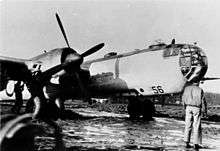Astrodome (aeronautics)
An astrodome is a hemispherical transparent dome fitted in the cabin roof of an aircraft to allow the use of a sextant during astro-navigation.[1]


Before the introduction of electronic means of navigation the only way to fix an aircraft's position at night was by taking star sights using a sextant, as had marine navigators for hundreds of years aboard ships. This requires a 360-degree view of the horizon; the astrodome was devised to allow this.
Astrodomes were prominent on many Royal Air Force (RAF) and Commonwealth-operated multi-engined aircraft of the Second World War, and on foreign aircraft ordered by them for their use, such as the Liberator and Dakota, as the RAF performed many of its operations and other flying at night.
Similar hemispherical-shape domes were also installed on some World War II heavy bombers to allow sighting of defensive, remotely operated gun turrets. They were featured on the Heinkel He 177A, with a single forward dorsal dome to aim its remotely operated FDL 131 twin MG 131 dorsal turret, and the complex sighting system for the American B-29 Superfortress heavy bomber's quartet of remote gun turrets. In the early 1960's astrodomes were still being employed in the USMC Lockheed Hercules GV-1 (later designated as C-130), with the navigator employing a bubble sextant hung from a hook in the middle of the dome. The USMC operated its Aerial Navigation School at MCAS Cherry Point, NC with graduates receiving their designation and wings as an Aerial Navigator.
Later use on ocean-racing yachts
In the 1950s and 60's, the use of astrodomes in aircraft was gradually phased out as radionavigation and ground plotting radars took over. Astrodomes did, however, enjoy a second career on ocean racing yachts (especially in singlehanded racing). Eric Tabarly, record-breaking winner of the 1964 OSTAR single-handed transatlantic race, and former French Aéronavale (Fleet air arm) pilot, had fitted his revolutionary lightweight ketch-rigged racer Pen Duick II with an astrodome scavenged from a Shorts Sunderland decommissioned aircraft.
Not only could he use it for sextant astro-navigation, but it provided a sheltered place from which he could steer his yacht during a stormy race. This was quite useful, as his wind-vane autopilot (also of aeronautical technology) had broken down.
References
- astrodome, definition at Webster's Online Dictionary